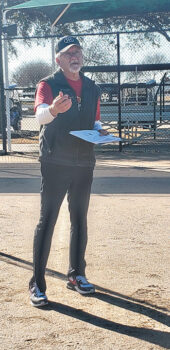
RR Softball 2023 pitching participants (left to right): Ramiro Escamilla, Peter Day, John McNemar, George Wendt, Gary Warrick, Sean Curry, Tom Gunther, William Smiley, Randy Catron, Becky Wyatt, Clyde Ziegler, Ty Nelson, Jeff Duncan, Tom Neagli, Paul Neal, Rhonda Gunther, David Pryde, and Dave Popejoy

Pitching Clinic coordinator John McNemar
Rosemary “Killer” Myers-Neagli
When people watch softball or baseball, they cheer about well-placed hits and fielding successes, but few think about the strategies or techniques a pitcher uses to throw the ball. But an experienced pitcher can frustrate players with throws that get batters grounding out or popping out consistently.
This spring our RR softball player/pitcher John McNemar organized the first “pitching clinic” to introduce more players interested in learning the “art” of this vital team position. John began the clinic with a review of pitching regulations, as set by the USA Senior Softball Association. The regulations define that the front plate of the pitcher’s box will measure 50 feet to the front edge of the home plate (batter’s box and strike zone mat). The height of a legal pitch, referred to as the arc, must be between 6 to 12 feet above the playing surface.
John was joined by several RRSA seasoned pitchers: Sean Curry, Ramiro Escamilla, Gary Warrick, and George Wendt, who contributed personal tips essential to pitching. Their first tip—gripping and releasing the ball was cited as the most important part of pitching. It is how you throw various pitches and how you can add a spin to the ball. While softball doesn’t have as many pitches to throw as baseball, they still can do quite a bit. A 2-seam grip, 4-seam grip, curveball, and a knuckleball are just a few variations. After the pitcher grips the ball, their wrist action can create a spin on the ball, and when the pitcher releases the ball, they can control the arc (height) and depth (where it lands on the strike mat). For a new pitcher, learning to consistently coordinate these three maneuvers is certainly an “art.”
Pitchers are also part of the infield defense. There is a huge gap between shortstop and second base. RR players try to not hit up the middle. We don’t want to hit the pitcher. However, many of us still hit close to the pitcher’s mound, forcing the pitcher to become that extra infielder. Our RR coaches explained that after throwing the ball, immediately back up five to seven steps to cover the gap. This gives the pitcher extra reaction time to any ball hit up the middle, and the pitcher could secure an out on a hit ground ball.
Studying the batter is also important. Some batters stand very close to home plate, and a pitcher will try to focus throwing inside, close to the player, causing them to hit foul balls or short ground balls. Others stand way off the plate, and a pitcher focuses throwing outside as far as possible, forcing a batter to reach out for the ball, again causing short ground balls or a “pop” fly ball. Additionally, pitchers can either throw towards the front of the strike zone mat or send balls deep to the rear of the strike zone mat, all dependent on where the batter chooses to stand.
The name of the game is to diversify and never keep any kind of pattern. It takes time to perfect the “art of pitching,” and the final tip from our RR pitch coaches: “Practice, Practice, and more Practice.”
